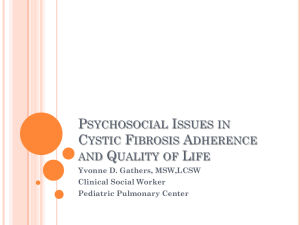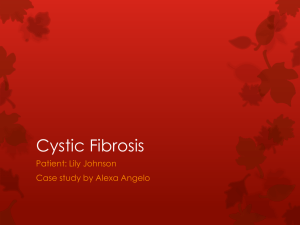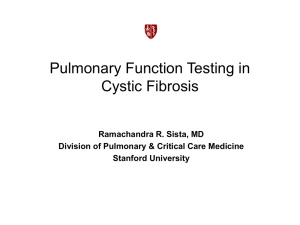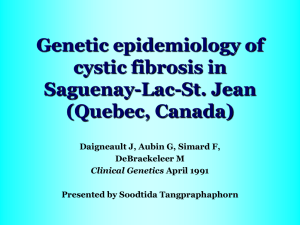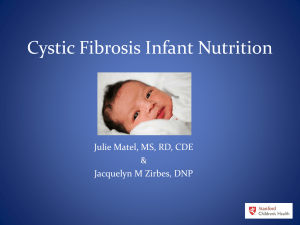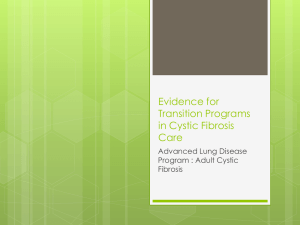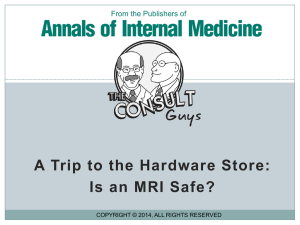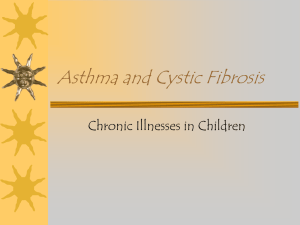MARKEY PATHWAY_11Oct11
advertisement
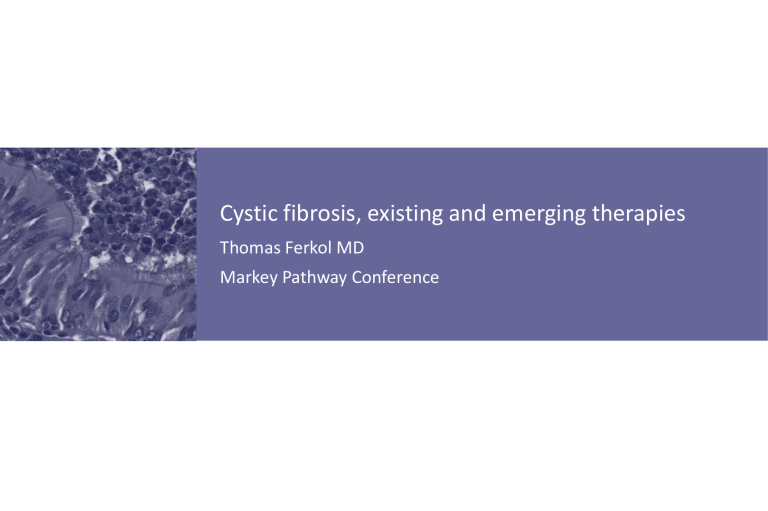
Cystic fibrosis, existing and emerging therapies Thomas Ferkol MD Markey Pathway Conference Cystic fibrosis: a historical timeline 1938 Cystic fibrosis (CF) of the pancreas was described by Andersen. 1953 The sweat defect was discovered by diSant'Agnese and colleagues when they noticed that many of the infants presenting with heat prostration during the “great summer heat wave” in New York City had CF. Cystic fibrosis was identified as an autosomal recessive disease. 1965 The fundamental physiologic defects were clearly established by Knowles and colleagues and Quinton as the failure of cAMP regulation of chloride transport. The genetic defect for CF was located on chromosome 7. The gene encoding the cystic fibrosis transmembrane conductance regulator (CFTR) was identified by positional cloning. 1983 1985 1989 1990 Cystic fibrosis transmembrane conductance regulator was established to be a cAMPregulated chloride channel by complementation studies. Cystic fibrosis: clinical presentations Gastrointestinal • meconium ileus • meconium plug syndrome • distal intestinal obstruction syndrome • rectal prolapse • neonatal hyperbilirubinemia • failure to thrive • hypoproteinemic edema • hypovitaminosis • recurrent pancreatitis • biliary cirrhosis and portal hypertension Endocrine diabetes Genitourinary • male infertility Sweat Gland Dysfunction • hypochloremic, hyponatremic alkalosis Respiratory • chronic cough • recurrent sinopulmonary infections • bronchiolitis/asthma • nasal polyposis • Staphylococcus aureus pneumonia • Pseudomonas aeruginosa endobronchitis Cystic fibrosis: epidemiology Population Epidemiologic Newborn screening Caucasian (US) 1 in 1,900-3,700 1 in 3,400-3,800 Caucasian (Great Britain) 1 in 2,400-3,000 1 in 2,200-3,200 Hispanic 1 in 8,000-9,000 -- African American 1 in 15,300 -- Native American 1 in 40,000 -- Asian (US, England) 1 in 10,000 -- Israel 1 in 5,000 -- 1 in 2,000-4,000 -- Southern Europe Median survival age (years) Cystic fibrosis: median survival age, 1940-2007 37.8 35 30 25 20 15 10 5 0 1940 1950 1960 1970 1980 Year 1990 2000 Cystic Fibrosis Foundation Registry, 2007. 2010 Cystic fibrosis: a historical timeline 1938 Cystic fibrosis (CF) of the pancreas was described by Andersen. 1953 The sweat defect was discovered by diSant'Agnese and colleagues when they noticed that many of the infants presenting with heat prostration during the “great summer heat wave” in New York City had CF. Cystic fibrosis was identified as an autosomal recessive disease. 1965 The fundamental physiologic defects were clearly established by Knowles and colleagues and Quinton as the failure of cAMP regulation of chloride transport. The genetic defect for CF was located on chromosome 7. The gene encoding the cystic fibrosis transmembrane conductance regulator (CFTR) was identified by positional cloning. 1983 1985 1989 1990 Cystic fibrosis transmembrane conductance regulator was established to be a cAMPregulated chloride channel by complementation studies. Cystic fibrosis: airway inflammation Normal Na+ Cl- Cystic fibrosis Na+ Cl- Cl- Cl- ENaC CFTR Cl-a K+ Na+ K+ Na+ 2Cl- K+ H2O Na+ Na+ 2Cl- K+ H2O Cystic fibrosis: nasal transepithelial potential difference amiloride Cl- free forskolin ATP -60 PD (mv) -50 normal -40 PD -30 -20 CF -10 0 0 4 6 Time (m) 8 10 Cystic fibrosis: a historical timeline 1938 Cystic fibrosis (CF) of the pancreas was described by Andersen. 1953 The sweat defect was discovered by diSant'Agnese and colleagues when they noticed that many of the infants presenting with heat prostration during the “great summer heat wave” in New York City had CF. Cystic fibrosis was identified as an autosomal recessive disease. 1965 The fundamental physiologic defects were clearly established by Knowles and colleagues and Quinton as the failure of cAMP regulation of chloride transport. The genetic defect for CF was located on chromosome 7. The gene encoding the cystic fibrosis transmembrane conductance regulator (CFTR) was identified by positional cloning. 1983 1985 1989 1990 Cystic fibrosis transmembrane conductance regulator was established to be a cAMPregulated chloride channel by complementation studies. Classes of cystic fibrosis-causing mutations ADP ADP ATP Class 3: regulatory mutants that fail to respond normally to activation signals, e.g., G551D PKA ATP Class 4: CFTR mutants that have altered channel properties, e.g., R117H ATP ADP Endosome Class 2: CFTR degradation in the endoplasmic reticulum, e.g., F508 Golgi Class 1: premature termination of CFTR mRNA translation, e.g., S489X ER Nucleus Class 5: decreased functional CFTR synthesis or transport, e.g., A455E Cystic fibrosis: clinical phenotype associated with CFTR mutations Severe lung disease Milder lung disease Mild lung disease Pancreatic insufficiency Pancreatic sufficiency Pancreatic sufficiency Abnormal sweat chloride Abnormal sweat chloride Equivocal sweat chloride F508 R117H (5T) R117H (7T) G542X 3849 + 10kB C-to-T 3849 + 10kB C-to-T G551D 2789 + 5 G-to-A G551S W1282X R334W D1152H N1303K G85E A455E R553X G91R 3120 + 1G-to-T R347P 1078 del T R347H R75X R347L Prospects for correcting cystic fibrosis: level of correction Chillon M, et al. N Engl J Med. 1996; 332:1475. Tissue affected CFTR activity 100% (wt, 9T/9T) unaffected vas deferens 50% (wt, 9T, and mutant CFTR) 10% (wt protein, 5T/5T) 5% (wt protein, 5T, and severe mutant) sweat duct airway 4% (R117H, 7T, and severe mutant) 1% (R117H, 7T, and severe mutant) pancreas <1% (G551D, F508) Pathogenesis of lung disease in cystic fibrosis Davis PB, et al. J Respir Crit Care Med. 1996;154:1229. Defective CF gene Defective/deficient CFTR Abnormal airway surface milieu Bronchial obstruction Infection Inflammation Bronchiectasis Treatment of cystic fibrosis lung disease Defective CF gene Defective/deficient CFTR Abnormal airway surface milieu Chest physiotherapy Mucolytics (rhDNase) Hypertonic saline Decrease mucus viscosity Augment clearance Bronchial obstruction Decrease bacterial load Infection Antibiotics Macrolides Reduce host response Inflammation Corticosteroids Ibuprofen Replace damaged lungs Bronchiectasis Transplantation Treatment of cystic fibrosis lung disease Defective CF gene Defective/deficient CFTR Abnormal airway surface milieu Chest physiotherapy Mucolytics (rhDNase) Hypertonic saline Decrease mucus viscosity Augment clearance Bronchial obstruction Decrease bacterial load Infection Antibiotics Macrolides Reduce host response Inflammation Corticosteroids Ibuprofen Replace damaged lungs Bronchiectasis Transplantation Cystic fibrosis: organisms isolated from the lower respiratory tract 100 P. aeruginosa Percentage positive 80 60 S. aureus 40 H. influenzae 20 B. cepacia 0 0-1 2-5 6-10 11-17 18-24 25-34 35-44 >45 Age (y) Data compiled from Cystic Fibrosis Foundation Patient Registry, 2007. Effect of Pseudomonas aeruginosa acquisition in cystic fibrosis Demko CA, et al. J Clin Epidemiol. 1995;48:1041 Late acquisition (>6y) Cumulative survival 1.0 0.9 0.8 Early acquisition (<6y) 0.7 0.6 males females 6 8 10 12 Age (y) 14 16 Cystic fibrosis: bacterial colonization Impaired mucociliary clearance asialoGM1 Increased adherence Impaired antimicrobial activity CFTR Antibacterial proteins Impaired phagocytosis Treatment of cystic fibrosis lung disease Defective CF gene Defective/deficient CFTR Abnormal airway surface milieu Chest physiotherapy Mucolytics (rhDNase) Hypertonic saline Decrease mucus viscosity Augment clearance Bronchial obstruction Decrease bacterial load Infection Antibiotics Macrolides Reduce host response Inflammation Corticosteroids Ibuprofen Replace damaged lungs Bronchiectasis Transplantation Cystic fibrosis: pathology Cystic fibrosis: radiological findings Cystic fibrosis: airway inflammation mac pmn NE O2- TNF-a IL-8 IL-1b respiratory epithelium Normal Cystic fibrosis Anti-inflammatory agents in cystic fibrosis: corticosteroids Eigen H, et al. J Pediatr. 1995;126:515. Lai HC, et al. N Engl J Med. 2000;342:851. FVC (% predicted for age A four year, randomized double-blind, placebo-controlled trial that compared the efficacy of two doses (1 mg/kg/d and 2 mg/kg/d) of alternate-day prednisone therapy with placebo in children with CF. 4 3 2 1 0 -1 -2 -3 -4 -5 -6 p = 0.0001 2 mg/kg 6 12 18 24 30 high-dose arm stopped 1 mg/kg 36 42 48 mos placebo Anti-inflammatory agents in cystic fibrosis: azithromycin Saiman L, et al. JAMA. 2003;290:1749. FEV1 (% predicted for age) An five-month, randomized, double-blind, placebo-controlled trial that examined the efficacy of azithromycin in patients with CF (age > 6 years, N = 251), chronically colonized with P. aeruginosa, and lung disease (FEV1 > 30% predicted for age). 5 4 3 2 1 0 -1 -2 -3 -4 -5 -6 p = 0.009 azithromycin 28 84 168 196 days placebo Drug stopped Cystic fibrosis: median survival age, 1940-2007 Median survival age (years) inhaled mucolytics 35 30 25 37.8 anti-Staphylococcus antibiotics airway clearance inhaled antibiotics 20 15 10 anti-Pseudomonas antibiotics 5 0 1940 1950 1960 1970 1980 Year 1990 2000 Cystic Fibrosis Foundation Registry, 2007. 2010 Treatment of cystic fibrosis lung disease Defective CF gene Defective/deficient CFTR Block uptake Increase Cl- efflux Abnormal airway surface milieu Amiloride UTP/ATP Hypertonic saline Decrease mucus viscosity Augment clearance Bronchial obstruction Mucolytics (rhDNase) Chest physiotherapy Decrease bacterial load Infection Antibiotics Macrolides Reduce host response Inflammation Corticosteroids Ibuprofen Replace damaged lungs Bronchiectasis Transplantation Na+ Cystic fibrosis: alternative therapies to effect bioelectric properties of the respiratory epithelium CF Altering other channels Na+ Cl- ENaC Na+ Cl- ClCa CFTR Cl- Amiloride UTP/ATP Hypertonic saline Aerosolized hypertonic saline for the treatment of cystic fibrosis Elkins MR, et al. N Engl J Med. 2006;354:229. An 48-week, randomized, double-blind, parallel-group trial that examined the efficacy of inhaled hypertonic saline in patients with CF over 6 years of age. Survival free of symptomdefined exacerbations (%) 100 75 p = 0.001 9.2 w 50 36 w hypertonic saline 25 control 0 0 12 24 36 Period of observation (w) 48 Treatment of cystic fibrosis lung disease Defective CF gene Defective/deficient CFTR VX809 VX770 PTC124 Block Na+ uptake Increase Cl- efflux Abnormal airway surface milieu Amiloride UTP/ATP Hypertonic saline Decrease mucus viscosity Augment clearance Bronchial obstruction Mucolytics (rhDNase) Chest physiotherapy Decrease bacterial load Infection Antibiotics Macrolides Reduce host response Inflammation Corticosteroids Ibuprofen Replace damaged lungs Bronchiectasis Transplantation Increase CFTR protein Activate mutant form Cystic fibrosis: correcting CFTR dysfunction Zeitlin P. N Engl J Med. 2004;351:606 F508 CFTR G551D CFTR Cell membrane Cell membrane VX770 Endosome Endosome Proteasome apical trafficking degradation Golgi post-translational folding translation ER Golgi Low temperature Glycerol ER transcription Nucleus VX809 Nucleus Cystic fibrosis: correcting G551D CFTR dysfunction Accurso FJ, et al. N Engl J Med. 2010;363:1991. A four-week, randomized placebo-controlled trial that compared the effect of regular treatment with VX770 with placebo in CF patients with G551D mutation. [Sweat chloride] (mmol/L) 120 placebo 100 80 VX770, 150 mg 60 VX770, 250 mg 40 20 0 3 14 21 28 days Cystic fibrosis: potentiating delF508 CFTR dysfunction A two-week, randomized double-blind, crossover trial that compared the effect of regular treatment with VX809 with placebo in CF patients with delF508 mutation. [Sweat chloride] (mmol/L) 0 -2 -4 -6 -8 -10 25 50 100 200 Gentamicin-induced correction of CFTR function in patients with cystic fibrosis and CFTR stop mutations Response of nasal PD to chloridefree isoproterinol (mV) Wilschanski M. N Engl J Med. 2003; 349:1433. -8 -6 p = 0.03 pre-treatment -4 -2 0 0 0.3 0.6 0.9 Gentamicin concentration (%) 1.2 post-treatment Treatment of cystic fibrosis lung disease Defective CF gene Gene therapy Increase CFTR protein Activate mutant form Defective/deficient CFTR VX809 VX770 PTC124 Block Na+ uptake Increase Cl- efflux Abnormal airway surface milieu Amiloride UTP/ATP Decrease mucus viscosity Augment clearance Bronchial obstruction Mucolytics (rhDNase) Chest physiotherapy Hypertonic saline Decrease bacterial load Infection Antibiotics Macrolides Reduce host response Inflammation Corticosteroids Ibuprofen Replace damaged lungs Bronchiectasis Transplantation Provide normal gene Active or completed human gene therapy protocols Infectious diseases (40) Human immunodeficiency virus (37) Other viral diseases (3) Monogenic diseases (58) Alpha1-antitrysin deficiency (2) Chronic granulomatous disease (3) Cystic fibrosis (23) Familial hypercholesterolemia (1) Fanconi anemia (4) Gaucher disease (3) Hunter syndrome (1) Ornithine transcarbamylase deficiency (1) Purine nucleoside phosphorylase deficiency (1) Severe combined immunodeficiency disease (6) Leukocyte adhesion deficiency (1) Canavan disease (3) Hemophilia (5) Muscular dystrophy (1) Amyotrophic lateral sclerosis (1) Junctional epidermolysis bullosa (1) Neuronal ceroid lipofuscinosis (1) Cancer (405) Other diseases(66) Peripheral artery disease (24) Arthritis (4) Arterial restenosis (3) Congestive heart failure (1) Coronary artery disease (21) Alzheimer disease (2) Ulcer (3) Bone fracture (1) Peripheral neuropathy (1) Parkinson disease (2) Eye disorders (4) Erectile dysfunction (1) Intractable pain (1) Administration of an adenovirus containing the human CFTR cDNA to the respiratory tract of individuals with cystic fibrosis Crystal RG, et al. Nat Genet. 1994;8:42. Pretreatment Pretreatment In vivo transfection In vivo transfection In vitro transfection In vitro transfection A controlled study of adenovirus-vector-mediated gene transfer in the nasal epithelium of patients with cystic fibrosis Knowles MR, et al. N Engl J Med. 1995;333:823. CFTR mRNA Patient No. Cohort 1 1 2 3 Cohort 2 1 2 3 Cohort 3 1 2 3 Cohort 4 1 2 3 MOI vehicle-treated vector-treated 1 1 1 no no no no no no 10 10 10 no no no no no yes 100 100 100 no no no yes no yes 1000 1000 1000 no no no yes no yes A controlled study of adenovirus-vector-mediated gene transfer in the nasal epithelium of patients with cystic fibrosis -40 -40 -30 -30 PD (mV) PD (mV) Knowles MR, et al. N Engl J Med. 1995;333:823. -20 -10 -20 -10 0 0 10 10 -5 0 5 Days 10 -5 0 5 Days 10 Effectiveness of current gene transfer vehicles used in cystic fibrosis Gene transfer vehicles Adenovirus Adeno-associated virus Retrovirus Murine leukemia virus Lentivirus Cationic liposomes Molecular conjugates DNA delivery yes yes RNA expression yes no CFTR function no no ND ND yes yes ND ND maybe no ND ND no maybe Prospects for gene therapy of cystic fibrosis: submucosal gland Engelhardt JF, et al. J Clin Invest. 1994;93:737. epithelium (+) duct (++++) submucosal glands (++) Sites of CFTR expression in the human airway http://www.medicine.mcgill.ca/dynhist/histoimages Prospects for gene therapy of cystic fibrosis: obstacles Respiratory epithelial cells vs submucosal glands. Unavailable target receptors. Inability to bypass physical and functional barriers in the airway. Possible biologic unsuitability of the airway epithelium as a target tissue. Immunologic consequences. Relevant outcome measure. Treatment of cystic fibrosis lung disease Provide normal gene Defective CF gene Gene therapy VX809 VX770 PTC124 Amiloride UTP/ATP Hypertonic saline Increase CFTR protein Activate mutant form Defective/deficient CFTR Block Na+ uptake Increase Cl- efflux Abnormal airway surface milieu Decrease mucus viscosity Augment clearance Bronchial obstruction Mucolytics (rhDNase) Chest physiotherapy Decrease bacterial load Infection Antibiotics Macrolides Reduce host response Inflammation Corticosteroids Ibuprofen Replace damaged lungs Bronchiectasis Transplantation
